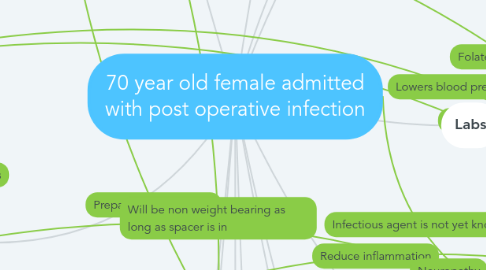
1. Procedures
1.1. 10/10 Irrigation and debridement with wound vac application
1.2. 10/12 Irrigation and debridement with wound closure
1.3. 11/7 - going in for irrigation and debridement with removal of deep implants and placement of antibiotic cement spacer
1.4. Nutritional consult scheduled for after surgery
1.5. Infections disease consult scheduled for after surgery.
2. Medications
2.1. Vitamin D
2.1.1. vitamin D deficiency;
2.1.2. S/E: kidney stones; confusion; muscle weakness
2.1.3. Interactions; corticosteroids, blood pressure or diabetes medication
2.1.4. Labs; to monitor D vitamin levels
2.1.5. Teaching: use protection from the sun
2.2. Folic acid
2.2.1. folate deficiency
2.2.2. S/E: bronchospasm, rash, n/v, flatulence
2.2.3. Interactions: corticosteroids, oral contraceptive, methotrexate
2.2.4. Labs: monitor plasma levels
2.2.5. Teaching: avoid alcohol; prolonged cooking of vegetables destroys natural folate
2.3. Furosemide
2.3.1. edema and hypertension
2.3.2. S/E: jaundice, tinnitus, hearing impairment, hypotension
2.3.3. Interactions: charcoal, propanolol
2.3.4. Labs: Monitor weigh, edemal, I&O and electrolytes
2.3.5. Teaching: take on an empty stomach, changes position slowly
2.4. Gabapentin
2.4.1. fibromyalgia
2.4.2. S/E: dizziness, somnolence, peripheral edema, ataxia, tremor
2.4.3. Interactions: alcohol, hydrocodone, morphine, cimetidine
2.4.4. Labs: Monitor renal and LFTs
2.4.5. Teaching: Do not take within 2 hours of antacids, avoid alcohol
2.5. Prednisone
2.5.1. rheumatoid arthritis
2.5.2. S/E: insomnia, n/v, GI upset, fatigue, dizziness, decreased diabetic control
2.5.3. Interactions: do not take with prednisolone or primidone
2.5.4. Labs: monitor CBC, ESR, electrolytes, weights, blood sugar
2.5.5. Teaching: do not stop abruptly, report s/sx of adrenal insufficiency, avoid alcohol
2.6. Bisoprolol
2.6.1. hypertension
2.6.2. S/E: dizziness, fatigue, headache, diarrhea, rhinitis
2.6.3. Labs: Monitor CBC, glucose, electrolytes, renal and LFTs
2.6.4. Teaching: change position slowly, report any difficulty breathing
2.7. Preoperative: Vancomycin
2.7.1. preoperative prophylaxis
2.7.2. S/E: ototoxicity, chills, coughing, drowsiness
2.7.3. Labs: CBC, cultures, renal function
2.7.4. Teaching: complete course as prescribed, stay hydrated
3. Impaired physical mobility related to spacer placement and non weight bearing status as manifested by limited range of motion, non weight bearing to LLE.
3.1. Obtain any assistive devices needed for activity.
3.2. Consult with physical therapy.
4. Ineffective peripheral tissue perfusion related to surgery and hypertension as manifested by delayed wound healing and edema.
4.1. Check dorsalis pedis, posterior tibial and popliteal pulses bilaterally.
4.2. Elevate legs and wear ACE wraps.
5. chronic kidney disease and chronic lymphocytic leukemia
6. Elective left total hip replacement
6.1. Hip replacement on 9/26
6.2. developed cellulitis around incision after one week
6.3. previous joint replacements (right hip and left knee) without complications
6.4. Continued to drain, redness, warmth, pain
7. Medical History
7.1. Chronic lymphocytic leukemia
7.2. Rheumatoid arthritis
7.3. Osteoarthritis
7.4. Hypertension
7.5. Chronic kidney disease
7.6. Peripheral edema
7.7. Vitamin D deficiency
7.8. Folate deficiency
7.9. Fibromyalgia
8. Psychosocial
8.1. husband present and supportive
8.2. worried about role as treasurer for her church
8.3. concerns about non weight bearing status after surgery
9. Labs
9.1. Sodium 146 mEq
9.1.1. possible dehydration
9.2. Crossmatch type and screen: B negative
9.2.1. preparation for surgery today
9.3. GFR 59 mL/min
9.3.1. chronic kidney disease
9.4. WBC 61.9 K/uL
9.4.1. chronic lymphocytic leukemia
9.5. RBC 3.79 M/uL
9.5.1. chronic kidney disease and chronic lymphocytic leukemia
9.6. Hematocrit 31.7%
9.7. Platelets 123 K/uL
9.7.1. Hemoglobin 11.5 g/dL
9.7.1.1. chronic kidney disease and chronic lymphocytic leukemia
9.7.2. folate deficiency and chronic lymphocytic leukemia
9.8. Calcium 8.4 mg/dL
9.8.1. Chronic kidney disease and vitamin D deficiency
9.9. Absolute Lymphocytes 40.5
9.9.1. Chronic lymphocytic leukemia
9.10. Blood cultures: pending
10. Diet
10.1. general diet ordered
10.1.1. minimal oral intake
10.1.2. reports loss of appetite
10.1.3. only eating ice chips
10.2. NPO status as of 0001 11/7
10.2.1. preparation for surgery

